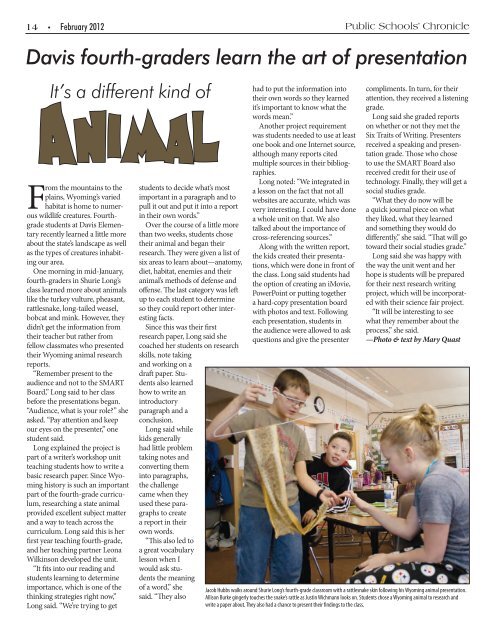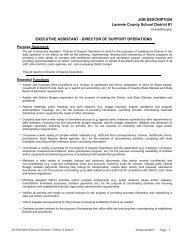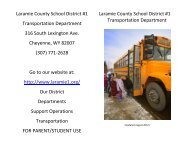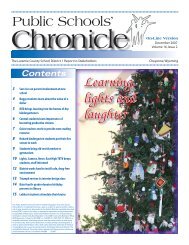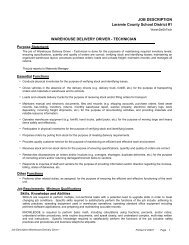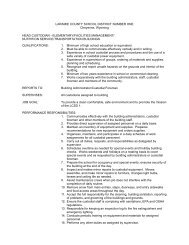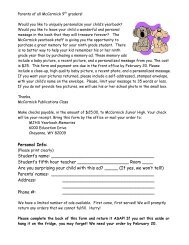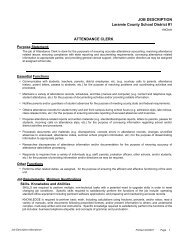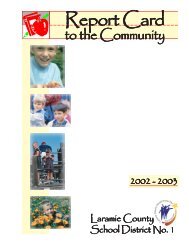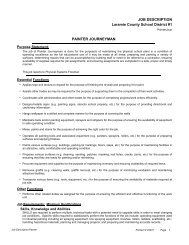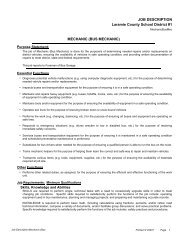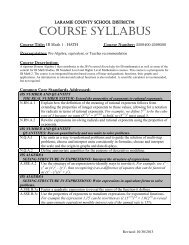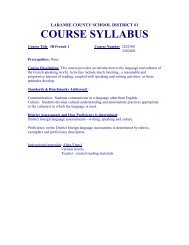February/March 2012 - Laramie County School District #01
February/March 2012 - Laramie County School District #01
February/March 2012 - Laramie County School District #01
- No tags were found...
Create successful ePaper yourself
Turn your PDF publications into a flip-book with our unique Google optimized e-Paper software.
14 • <strong>February</strong> <strong>2012</strong> Public <strong>School</strong>s’ ChronicleDavis fourth-graders learn the art of presentationIt’s a different kind ofAnimalFrom the mountains to theplains, Wyoming’s variedhabitat is home to numerouswildlife creatures. Fourthgradestudents at Davis Elementaryrecently learned a little moreabout the state’s landscape as wellas the types of creatures inhabitingour area.One morning in mid-January,fourth-graders in Shurie Long’sclass learned more about animalslike the turkey vulture, pheasant,rattlesnake, long-tailed weasel,bobcat and mink. However, theydidn’t get the information fromtheir teacher but rather fromfellow classmates who presentedtheir Wyoming animal researchreports.“Remember present to theaudience and not to the SMARTBoard,” Long said to her classbefore the presentations began.“Audience, what is your role?” sheasked. “Pay attention and keepour eyes on the presenter,” onestudent said.Long explained the project ispart of a writer’s workshop unitteaching students how to write abasic research paper. Since Wyominghistory is such an importantpart of the fourth-grade curriculum,researching a state animalprovided excellent subject matterand a way to teach across thecurriculum. Long said this is herfirst year teaching fourth-grade,and her teaching partner LeonaWilkinson developed the unit.“It fits into our reading andstudents learning to determineimportance, which is one of thethinking strategies right now,”Long said. “We’re trying to getstudents to decide what’s mostimportant in a paragraph and topull it out and put it into a reportin their own words.”Over the course of a little morethan two weeks, students chosetheir animal and began theirresearch. They were given a list ofsix areas to learn about—anatomy,diet, habitat, enemies and theiranimal’s methods of defense andoffense. The last category was leftup to each student to determineso they could report other interestingfacts.Since this was their firstresearch paper, Long said shecoached her students on researchskills, note takingand working on adraft paper. Studentsalso learnedhow to write anintroductoryparagraph and aconclusion.Long said whilekids generallyhad little problemtaking notes andconverting theminto paragraphs,the challengecame when theyused these paragraphsto createa report in theirown words.“This also led toa great vocabularylesson when Iwould ask studentsthe meaningof a word,” shesaid. “They alsohad to put the information intotheir own words so they learnedit’s important to know what thewords mean.”Another project requirementwas students needed to use at leastone book and one Internet source,although many reports citedmultiple sources in their bibliographies.Long noted: “We integrated ina lesson on the fact that not allwebsites are accurate, which wasvery interesting. I could have donea whole unit on that. We alsotalked about the importance ofcross-referencing sources.”Along with the written report,the kids created their presentations,which were done in front ofthe class. Long said students hadthe option of creating an iMovie,PowerPoint or putting togethera hard-copy presentation boardwith photos and text. Followingeach presentation, students inthe audience were allowed to askquestions and give the presentercompliments. In turn, for theirattention, they received a listeninggrade.Long said she graded reportson whether or not they met theSix Traits of Writing. Presentersreceived a speaking and presentationgrade. Those who choseto use the SMART Board alsoreceived credit for their use oftechnology. Finally, they will get asocial studies grade.“What they do now will bea quick journal piece on whatthey liked, what they learnedand something they would dodifferently,” she said. “That will gotoward their social studies grade.”Long said she was happy withthe way the unit went and herhope is students will be preparedfor their next research writingproject, which will be incorporatedwith their science fair project.“It will be interesting to seewhat they remember about theprocess,” she said.—Photo & text by Mary QuastJacob Hubbs walks around Shurie Long’s fourth-grade classroom with a rattlesnake skin following his Wyoming animal presentation.Allison Burke gingerly touches the snake’s rattle as Justin Wichmann looks on. Students chose a Wyoming animal to research andwrite a paper about. They also had a chance to present their findings to the class.


